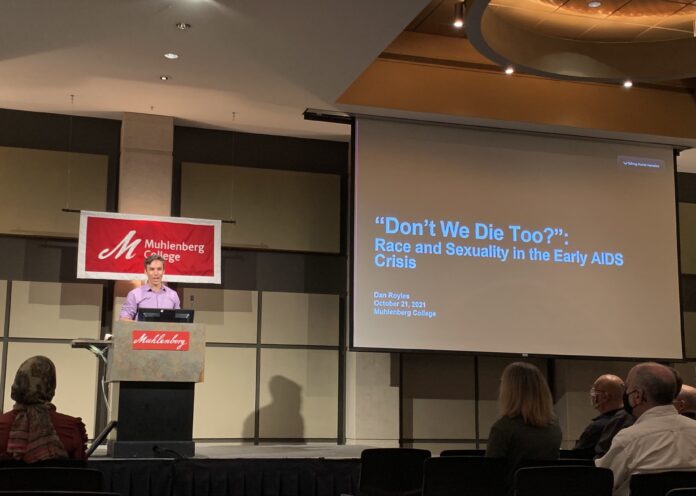Author and historian Dan Royles gave insight on the HIV/AIDS epidemic in Moyer Hall last Thursday, Oct. 21. He discussed its disproportionate impacts on the Black community in the United States when compared to the white population. At the start of his lecture, Royles shared some information from his book project, “To Make the Wounded Whole: The African American Struggle Against HIV/AIDS.”
“African Americans make up about 12 percent of the United States’ population, but about 42 percent of new diversities of HIV,” Royles explained. “The largest group, in terms of absolute numbers of new cases of HIV, are Black gay or bisexual men. If numbers like these hold, one in two Black gay men can expect to contract HIV within their lifetime.”
Royles then delved into the history of the AIDS epidemic in relation to the disproportionate amount of African Americans who contract HIV/AIDS.
“The largest group, in terms of absolute numbers of new cases of HIV, are Black gay or bisexual men. If numbers like these hold, one in two Black gay men can expect to contract HIV within their lifetime.”
“Very often when we’re talking about AIDS history or activism history, it is the the history of white gay men. When we do talk about the ways that the Black community has reacted to the AIDS epidemic, we often talk about them in terms of their deficits. These narratives assume that the Black communtiy is homophobic or there is denial in Black communities, which is why the disparity is so great.”
This common idea is rejected in Royles’ new book as he focuses more on the positive responses that Black communities have made to the HIV/AIDS epidemic. He started exploring this subject during his time at Temple University when writing a research paper on AIDS activism in Philadelphia. He then discovered the story of Rashidah Abdul-Khabeer (nee Hassan) and her organization “BEBASHI,” an acronym for “Blacks Educating Blacks About Sexual Health Issues.”
“My idea of AIDS activism was kicked by a group called ACT UP. It was a diverse group but it was also a group that was led by middle-class white gay men and women. This is the mental image that I had of an AIDS activist, and finding the story of Rashida Hassan exploded that for me.”
Royles introduced the “gayborhood,” a neighborhood in downtown Philadelphia comprised of mostly white gay men. This small community created tension as AIDS organizations were mostly focused on the gayborhood rather than the large amounts of gay Black men in other parts of the city.
“This early set of tensions butt heads in 1986 in the city’s first Candlelight AIDS Walk. There was conversation of where the walk should take place,” said Royles. “Some said it should take place through the gayborhood while others said the disease is already marked as white gay males, so we need a route that gets outside the gayborhood.”
Royles then explained that Hassan resigned as vice president of Philadelphia Community Health Alternatives, parent organization to the Philadelphia AIDS Task Force, at the end of the walk with a riveting speech. She resigned due to restructuring that took the right to distribute funds out of the hands of a committee and into the hands of PCHA’s president. She brought these issues of unrepresented Black males in Philadelphia and continued to hold seminars and workshops through BEBASHI to continue supporting this community.
He then described the difficulties faced by multiple AIDS organizations in terms of finances, followed by the racism inherent in the situations.
“In BEBASHI’s case, the wrongdoing of Hassan using money for her wardrobe was assumed without evidence, and in the case of the [Philadelphia] AIDS Task Force, predominantly led by white males, the president [of PCHA] was proven for stealing the organization’s money. And yet, the AIDS Task Force was the organization that continued to grow.”
Royles connected these funding issues to the lack of support from the government for the AIDS epidemic.
“The government, federal, state and local, failed to respond to AIDS as a health crisis, and in failing to respond, left the responsibility to private non-profit groups,” said Royles. “The amount of public resources devoted to fighting AIDS has never been enough.”
“After listening to the lecture, I found it very interesting to learn about another side of the AIDS movement that was…equally as important to the major players in the news,” remarked Jake Azrolan ‘21.
“The amount of public resources devoted to fighting AIDS has never been enough.”
“I also thought it did a very good job of touching on themes of shame and guilt, passive and active bystanders, and how stories are told,” added Aevyn Barnett ‘22.
To finish, Royles argued that, “The deeper epidemic is all the things that AIDS exposed: inequality, white supremacy, corporate greed. And until we deal with those problems, the next epidemic will come along and expose them all over again. Look, it has already happened with COVID-19.”






















